[Column] Rave and media: Archiving unrecorded music culture
Column en 90s Euro History Psy-Trance Rave Zine![[Column] Rave and media: Archiving unrecorded music culture](/../assets/images/column-rave-media.webp)
Music that was supposed to disappear
| Text: mmr | Genre: Cultural records/media considerations | Theme: Chasing the traces of disappearing music |
Rave was an ad-hoc celebration of sound and light, and was basically a culture that did not assume that it would be recorded. Rave, whether in a club or outdoors, is a here-and-now experience, destined to be forgotten and never archived.
However, in the 21st century, with the advent of YouTube, SNS, and archive sites, ““cultures that were supposed to be unrecorded’’ are beginning to be recorded and reevaluated. This change is extremely interesting from both media and music culture perspectives.
Rave, a space without media
● The essence of rave is “anti-media”
Rave culture in the 1990s (particularly underground raves in the UK, Germany, the Netherlands, and Japan) avoided media exposure and documentation.
Legal risks (illegal parties and drug problems)
Rebellion against commercialism (not “music that sells”)
The “physical experience” at that moment is everything (realized from records)
In other words, the rave was “live” in every sense of the word. It was aesthetics and politics to distance yourself from the media.
Unrecorded music culture
● Examples of what was lost:
DJ set (recording was prohibited at the time)
On-site VJ video and lighting production
Venue air, smoke, smell, temperature
Nonverbal interaction between spectators
Rave was not a sound source or score, but a phenomenon itself. Therefore, such records have fundamentally different challenges than ordinary music archives.
Who archives? Media deterioration
● Spontaneous Archives from the Underground
Since the 2000s, the following attempts have begun around the world.
MixesDB, Discogs: Information collection of setlists and minor sound sources
YouTube/SoundCloud: Upload old mixtapes and pirated recordings
Reddit, Forum, Blog: Verbalization of experiences at the time
Zine/Podcast/Documentary: Preservation movement with a DIY spirit
These are grassroots archives that fill areas not covered by traditional music media (magazines, labels, broadcasters).
Disruption and restoration of club culture
● The reason why there are few records in Japan
According to the Entertainment Business Law, clubs were classified as “entertainment businesses.”
It was easy to avoid taking photos and videos (especially in Shibuya and Roppongi)
Magazine media (such as ““LOUD” and ““ele-king”) could only follow a limited scope.
As a result, the Tokyo rave of the 1990s only exists “in memory.”
● Recent developments
Citizen movement to preserve club culture (review of entertainment business law)
“Japan Rave Archive” and Zine projects are starting up
Archive of past footage of Shibuya WOMB and ageHa
Aggressive archiving is underway overseas
Established in 2007, “Rave Archive” is an archive that preserves and shares memories of 90s rave culture. From the perspective of a raver and an archivist, I will pass on a culture that tends to disappear to future generations.
Don’t miss the Archive of Old Rave Flyers from 1989-2000 from across the U.S. and Canada.
The value of “irregular archives” in the digital age
Many of the archives we rely on today are “unauthorized.”
・Mixtape with no label
-
Low quality video imported from VHS
-
Anonymous user memory-based setlists
However, this is also the most vivid means of preserving the ““reality of the place’’ at rave. Rather than institutionalized cultural heritage, a collection of “fragments of memories” pulsating underground is now becoming a single “cultural heritage.”
Conclusion: How to preserve unrecorded culture
Rave was an “art of experience.” It is impossible to record this and pass it on to future generations using normal music archiving methods alone.
However, the accumulation of memories, fragments, reinterpretations, and “passion” is making this possible. The time has come for those of us who have grown up with media to go beyond media and reconsider how we archive culture.
Related columns
🔗 [Column] Acid House: Chemical reactions of sound and cultural transformation
🔗 [Column] Psy-Trance (psychedelic trance) history, masterpieces, and 10 recommended tracks
🔗 [Column] Memories of speed where Initial D and music intersect
🔗 [Column] Eurobeat and Japan: Why are they linked together?
🔗 [Column] Cultural relationship between Initial D and Eurobeat
🔗 [Column] What was 90s Euro music? ──A feast of dance floors and melodies



![[Column] Synthpop: The era of electronic dreams](/../assets/images/column-synth-pop.webp)
![[Column] Aesthetics of imperfection ─ A new aesthetic of pop living in an era of imperfection](/../assets/images/column-the-aesthetics-of-imperfection.webp)
![[Column] Strange Musical Toys — Toys with strange sounds from around the world](/../assets/images/column-strange-musical-toys.webp)
![[Column] Beyond Drift: Eurobeat/EDM and the future form of](/../assets/images/column-initiald-eurobeat3.webp)
![[Column] RE/Search: Magazines that record subcultures and their cultural influence](/../assets/images/column-research.webp)
![[Column] Can Zine Save Rave? : Possibility of DIY media as a storage device](/../assets/images/column-rave-zine-save.webp)
![[Column] Desert City: History, anecdotes, and modern significance of Burning Man](/../assets/images/column-burningman.webp)
![[Column] Euro music and club culture: the intersection of radio and rave](/../assets/images/column-euro-club-culture.webp)
![[Column] Memories of speed where Initial D and music intersect](/../assets/images/column-initiald-eurobeat2.webp)
![[Column] From the intersection of disco and Japanese culture to the present — history, masterpieces, equipment, club culture](/../assets/images/column-disco-japan.webp)